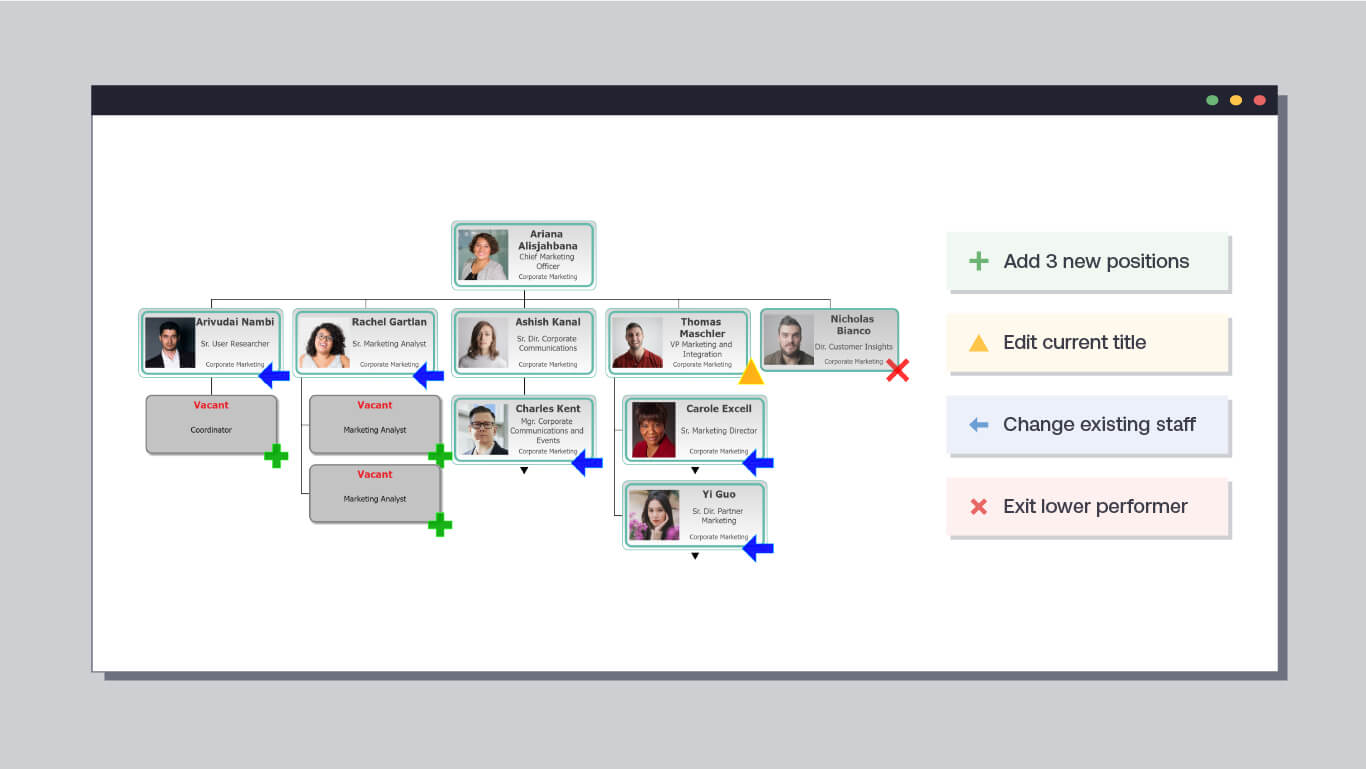March 13, 2024
7:46 AM
By OrgChart Team
Workforce planning systems offer HR leaders a strategic framework to align headcount and employee skill sets with business objectives. With advanced analytics, scenario planning capabilities, and focus on long-term planning, these systems empower businesses to anticipate and address future talent challenges proactively, ultimately driving greater efficiency, agility, and competitiveness.
Workforce planning systems are sophisticated tools designed to strategically manage an organization’s human resources. They integrate data analysis, forecasting techniques, and strategic planning to align the workforce with organizational goals and objectives. Essentially, these systems enable businesses to anticipate future talent needs, identify skill gaps, and develop strategies to address them proactively.
Traditionally, HR management relied on reactive approaches – such as recruitment drives or training programs – initiated in response to immediate needs. However, workforce planning systems offer a more proactive and holistic approach that leaders and employees are seeking.
And while traditional methods focus on addressing current staffing requirements, workforce planning systems take a long-term perspective, considering factors like projected growth, market trends, and changing skill demands. By leveraging people analytics and scenario planning, these systems enable organizations to make informed decisions about their workforce, rather than reacting to immediate challenges.
Workforce management software can offer a range of features, including:
Talent Management: These systems support comprehensive talent management strategies, from recruitment and onboarding to performance management and succession planning. By aligning talent initiatives with organizational objectives, workforce planning systems help businesses attract, retain, and develop top talent.

Workforce planning systems offer a multitude of benefits to organizations across various industries. From enhancing forecasting accuracy to optimizing resource allocation, these systems play a pivotal role in driving organizational success.
One of the key benefits of workforce planning systems is their ability to improve workforce forecasting accuracy. By leveraging sophisticated tools like OrgChart, organizations can analyze historical data and business projections to predict future talent needs with greater precision.
Forecasting abilities enable businesses to anticipate changes in staffing requirements, identify potential skill gaps, and develop proactive strategies to address them. With OrgChart, organizations can also visualize their current workforce structure, identify key talent pools, and model different scenarios to optimize workforce planning efforts.
Workforce planning systems also contribute to enhanced budget accuracy by aligning staffing requirements with financial projections. By integrating workforce data with financial metrics, these systems enable organizations to forecast labor costs more accurately and allocate resources efficiently. Of course, accurate forecasting ensures that budgets are aligned with strategic objectives and that resources are allocated optimally to support organizational goals.
Additionally, workforce planning systems facilitate scenario planning, allowing organizations to assess the financial impact of different workforce strategies and make informed decisions to optimize budget allocation.
Another significant benefit of HR planning tools are their ability to enhance talent acquisition and retention strategies. These tools provide insights into current talent demographics, skills gaps, and turnover rates, enabling organizations to identify areas for improvement and develop targeted recruitment and retention initiatives. By aligning talent strategies with business objectives, workforce planning systems help organizations attract and retain top talent, reduce turnover costs, and foster a more engaged and productive workforce.
Workforce planning systems play a crucial role in optimizing resource allocation by aligning staffing levels with operational demands. These systems enable organizations to analyze workload distribution, identify inefficiencies, and optimize workforce deployment to maximize productivity and efficiency. By ensuring that the right people are in the right roles, workforce planning systems help organizations minimize costs, improve operational performance, and enhance customer satisfaction.
Implementing workforce planning systems requires careful planning, collaboration, and integration with your existing HR infrastructure. By following best practices and addressing common challenges, organizations can successfully deploy these systems and maximize their effectiveness in driving strategic workforce management.
Include the following best practices for seamless integration into your current workforce strategy.
There are always challenges when implementing a new strategy or software. Consider the following as you prepare your team for the transition.
By understanding these issues and hesitations ahead of time, you’ll be better prepared to address an obstacle when it arises.
Implementing your new workforce management software is only half the battle. You must also ensure consistent and accurate use after its rollout to maximize its ROI and effectiveness. It’s best to:
By following these best practices, addressing common challenges, and implementing post-implementation tips, organizations can successfully deploy and maximize the effectiveness of workforce planning systems, ultimately driving strategic workforce management and organizational success.
Workforce management software offers a range of benefits to organizations seeking to optimize their human capital management processes. From improving workforce forecasting accuracy to enhancing budget accuracy, talent acquisition, retention strategies, and resource allocation, these systems empower organizations to make data-driven decisions, mitigate risks, and drive business success.
Moreover, when you choose an HR tool like OrgChart, you’ll equip your leaders with the right information and data to hit their goals now and in the future. Interested in seeing how OrgChart can help your organization?
Tags: